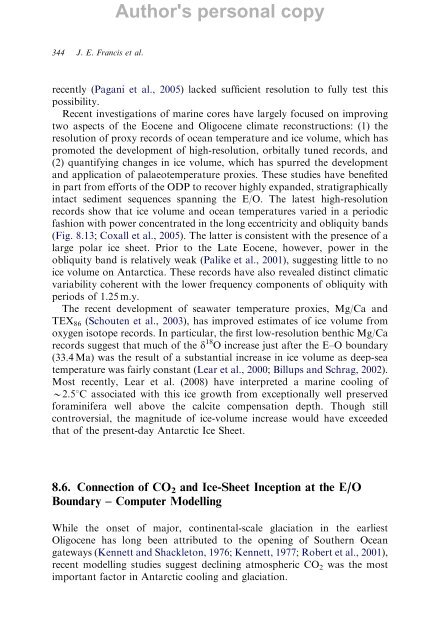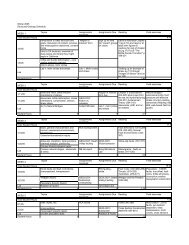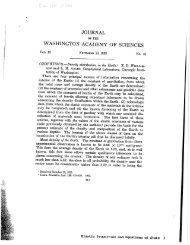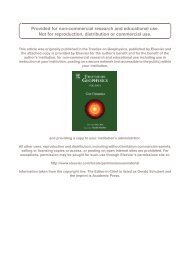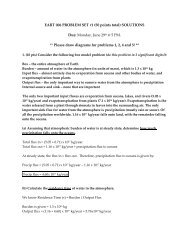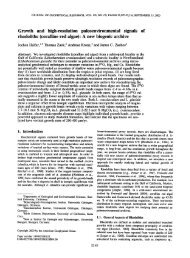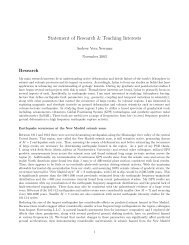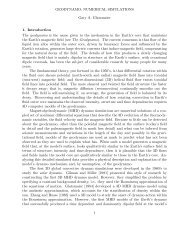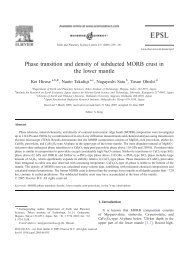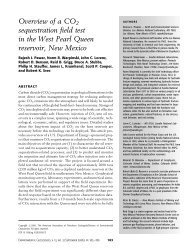From Greenhouse to Icehouse – The Eocene/Oligocene - UMass ...
From Greenhouse to Icehouse – The Eocene/Oligocene - UMass ...
From Greenhouse to Icehouse – The Eocene/Oligocene - UMass ...
You also want an ePaper? Increase the reach of your titles
YUMPU automatically turns print PDFs into web optimized ePapers that Google loves.
344 J. E. Francis et al.<br />
Author's personal copy<br />
recently (Pagani et al., 2005) lacked sufficient resolution <strong>to</strong> fully test this<br />
possibility.<br />
Recent investigations of marine cores have largely focused on improving<br />
two aspects of the <strong>Eocene</strong> and <strong>Oligocene</strong> climate reconstructions: (1) the<br />
resolution of proxy records of ocean temperature and ice volume, which has<br />
promoted the development of high-resolution, orbitally tuned records, and<br />
(2) quantifying changes in ice volume, which has spurred the development<br />
and application of palaeotemperature proxies. <strong>The</strong>se studies have benefited<br />
in part from efforts of the ODP <strong>to</strong> recover highly expanded, stratigraphically<br />
intact sediment sequences spanning the E/O. <strong>The</strong> latest high-resolution<br />
records show that ice volume and ocean temperatures varied in a periodic<br />
fashion with power concentrated in the long eccentricity and obliquity bands<br />
(Fig. 8.13; Coxall et al., 2005). <strong>The</strong> latter is consistent with the presence of a<br />
large polar ice sheet. Prior <strong>to</strong> the Late <strong>Eocene</strong>, however, power in the<br />
obliquity band is relatively weak (Palike et al., 2001), suggesting little <strong>to</strong> no<br />
ice volume on Antarctica. <strong>The</strong>se records have also revealed distinct climatic<br />
variability coherent with the lower frequency components of obliquity with<br />
periods of 1.25 m.y.<br />
<strong>The</strong> recent development of seawater temperature proxies, Mg/Ca and<br />
TEX 86 (Schouten et al., 2003), has improved estimates of ice volume from<br />
oxygen iso<strong>to</strong>pe records. In particular, the first low-resolution benthic Mg/Ca<br />
records suggest that much of the d 18 O increase just after the E<strong>–</strong>O boundary<br />
(33.4 Ma) was the result of a substantial increase in ice volume as deep-sea<br />
temperature was fairly constant (Lear et al., 2000; Billups and Schrag, 2002).<br />
Most recently, Lear et al. (2008) have interpreted a marine cooling of<br />
B2.51C associated with this ice growth from exceptionally well preserved<br />
foraminifera well above the calcite compensation depth. Though still<br />
controversial, the magnitude of ice-volume increase would have exceeded<br />
that of the present-day Antarctic Ice Sheet.<br />
8.6. Connection of CO2 and Ice-Sheet Inception at the E/O<br />
Boundary <strong>–</strong> Computer Modelling<br />
While the onset of major, continental-scale glaciation in the earliest<br />
<strong>Oligocene</strong> has long been attributed <strong>to</strong> the opening of Southern Ocean<br />
gateways (Kennett and Shackle<strong>to</strong>n, 1976; Kennett, 1977; Robert et al., 2001),<br />
recent modelling studies suggest declining atmospheric CO2 was the most<br />
important fac<strong>to</strong>r in Antarctic cooling and glaciation.


